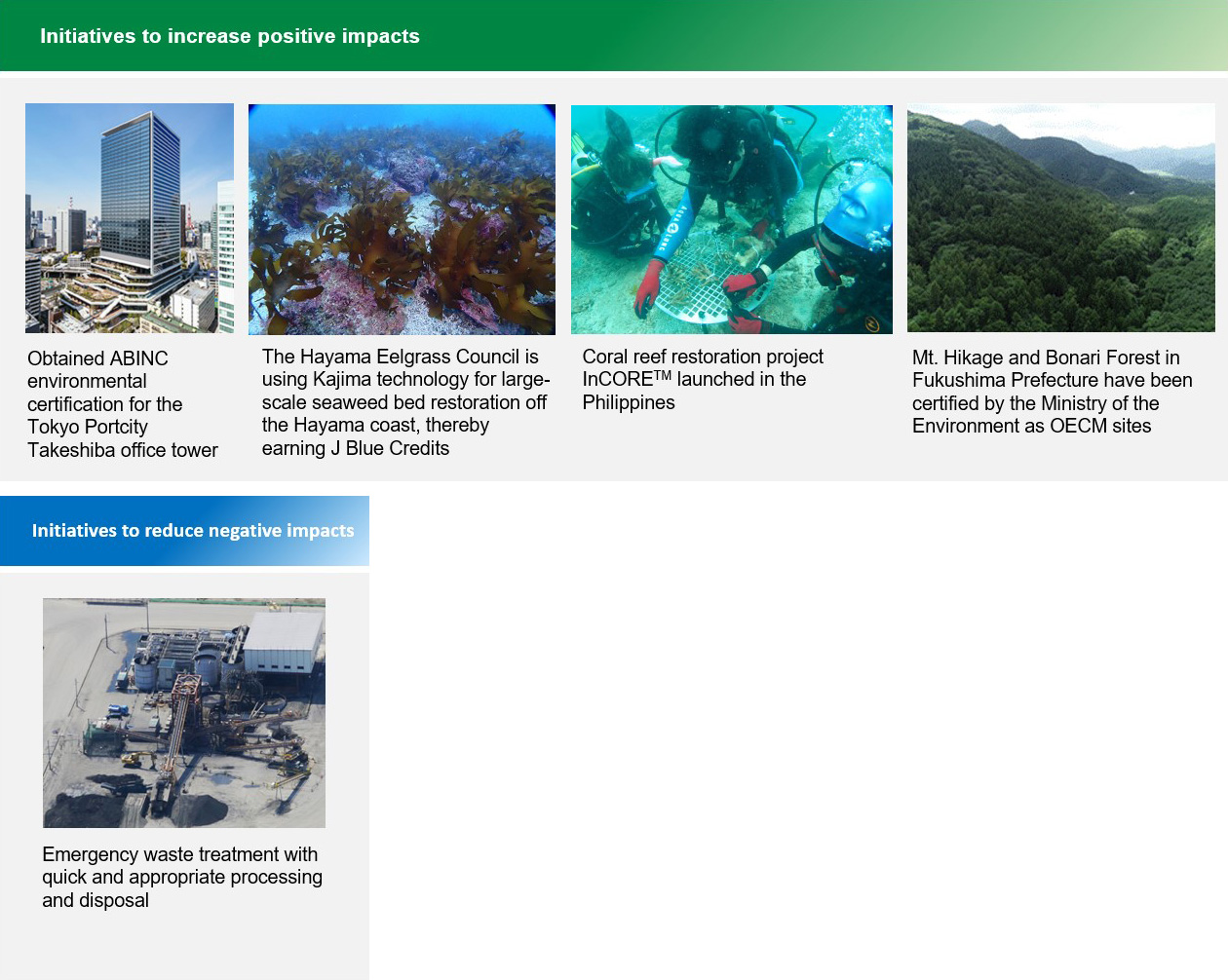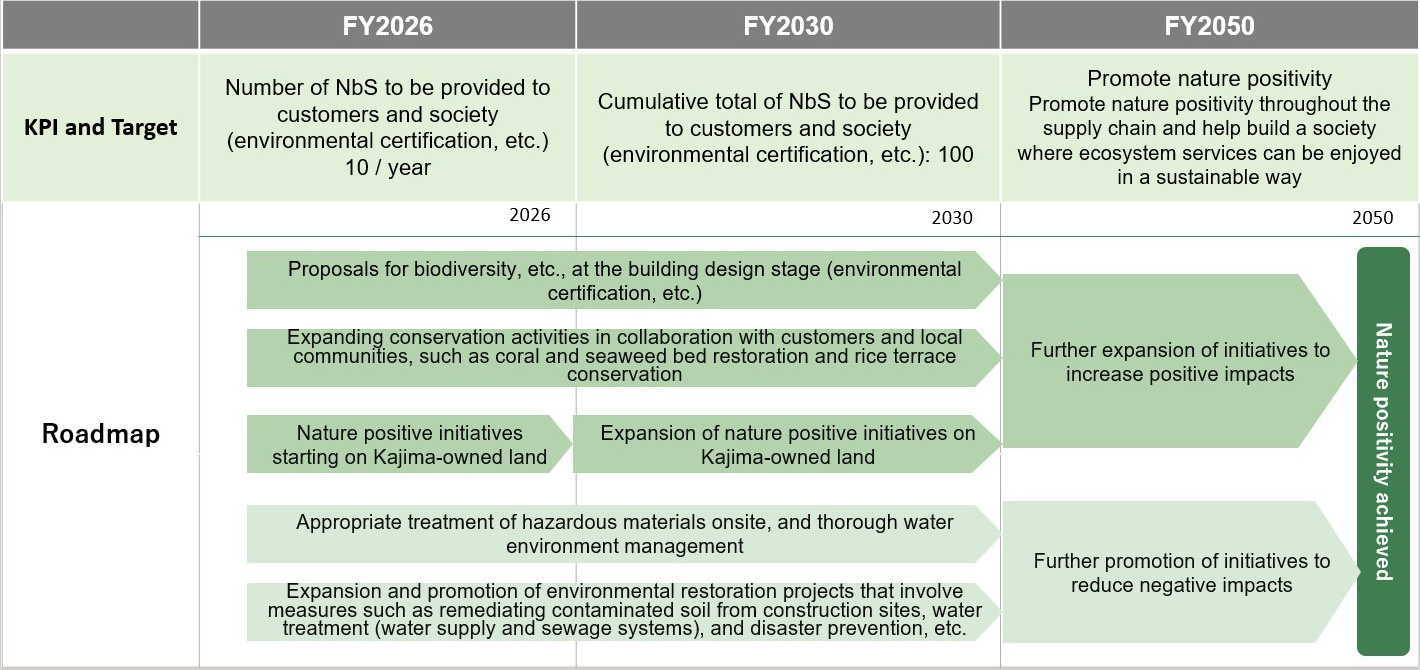Nature Positivity
The construction and development industries significantly alter the natural environment of project sites through their own operations (construction work). Due to the large quantities of construction materials used, they are also indirectly involved in environmental changes at material extraction sites and demolition waste disposal sites in their supply chains. Therefore, efforts to promote nature positivity are crucial.
Thus far, Kajima has focused on biodiversity conservation activities, such as the conservation of rare species, based on the goal of harmoniously co-existing with nature. However, from now on, Kajima’s goals will be based on the concept of nature positivity, which involves striving both to halt and reverse biodiversity loss.
What are Kajima's nature positivity goals?
(1) Eliminate negative impact on the environment (implement measures to reduce negative impact)
- Proper onsite handling of hazardous materials, and thorough water management
(2) Help revive and regenerate the natural environment (biodiversity, etc.) by implementing initiatives to increase positive impact
- Providing NbS to customers/society (including the acquisition of third-party environmental certification and awards, etc.)
- Environmental restoration on Kajima-owned land (registration of company-owned forests as effective area-based conservation measure (OECM) sites, etc.)

KPIs, Targets, and Roadmap

Harmoniously Co-Existing with Nature through Projects
Under the concept of "Many creatures are living in Kajima Biophilic Cities," an initiative to strengthen urban ecological networks through its business operations, Kajima is developing green infrastructure by building facilities and utilizing land while proactively incorporating the forces inherent in nature.
When we replaced Kajima Technical Research Institute, located in Chofu City, Tokyo, with a new building, we worked on a concept to make the area greener. These efforts included the restoration of groves with native species based on investigations on the plants in surrounding green areas. Since then, we have continuously carried out surveys to monitor the ecosystem with a particular focus on birds. This initiative was selected as one of the Top 100 Corporate Biodiversity Preservation Projects.
Utilization of Kajima-Owned Forests
The Kajima Group owns approximately 5,500 hectares of forest and has managed these woodlands for over 100 years. During this time, the company has also consistently focused on environmental greening in its development of national infrastructure and urban spaces. This effort has included nurturing and strengthening construction and management companies specializing in greening, and establishing a landscape design department earlier than others in the industry. By leveraging its knowledge to add greenery in various settings, Kajima aims to help achieve the SDGs, ESG goals, and carbon neutrality, as well as enhance the social and customer value it provides.
Conservation and Restoration of Eelgrass Beds and Coral Reefs
Biodiversity loss is a global issue just as urgent as global warming. Businesses have a significant role in addressing this problem, and the construction industry in particular, since it builds social infrastructure, impacts and shapes local ecosystems. Kajima has long focused on coexisting harmoniously with ecosystems and has been pursuing various research and technology development efforts related to the conservation and restoration of not only terrestrial but also aquatic environments.
Efforts in the Construction Phase
At construction sites, we work from multiple perspectives from the planning stage to minimize the impact of noise and vibration on surroundings, and we work on biodiversity preservation activities, including the preservation of rare species.
We make an environmental assessment at the early stages of our development plans, including action to consider the impact on biodiversity. The environmental assessment involves the following activities conducted in order: investigating current conditions, making predictions, producing evaluations, discussing environment preservation measures, drafting an environmental impact statement, sending it for review by the local government, preparing an environmental impact statement, and holding a follow-up investigation. By incorporating environmental considerations into our plans, we are able to make changes to the plan and consider alternative plans, thereby minimizing environmental impact. Kajima predicts and assesses the impact of development on each area through simulations and model experiments, and we use the results for biodiversity conservation and a variety of other measures.
In addition, we have implemented a system at all of our constructions sites for extracting risks in the planning phase and tracking them up to project completion. If we identify any potentially negative impact on the biodiversity of the area, we formulate and implement a Biodiversity Action Plan (BAP) to conserve biodiversity in cooperation with the Kajima Technical Research Institute and other organizations.
At dam construction and land creation sites, the geography and other conditions change drastically as construction progresses. As such, it is important to engage in continued monitoring and carry out appropriate measures for preserving the flora, fauna, and the natural environment in the local area. Kajima developed “Ikimono Note”, a system for monitoring flora, fauna, and the surrounding environment using an iPad so that even non-expert employees can carry out these activities with ease. We also share and accumulate information with the Kajima Technical Research Institute and other organizations to achieve accurate and swift action.

